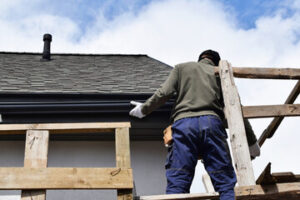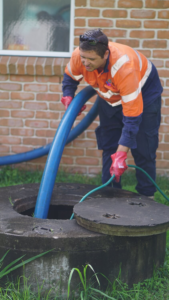A sagging section of fence can become unsafe, so it is important to identify the problem and address it promptly. Leaning posts may need to be dug up and re-anchored in concrete, or simply braced with two-by-fours.

A service technician can clean off rust and repaint a damaged section to refresh its appearance. These types of repair are typically less costly than a full replacement. Contact Fence Repair Summerville for professional help.
Fence posts are a key structural component in the overall integrity of your fence. They support the weight of fence boards and rails, and help absorb the impact of heavy winds or soil erosion. If a fence post is broken, it can lead to a significant loss of stability and may weaken the rest of the fencing. Luckily, there are several effective methods for repairing damaged fence posts. One option involves splicing the broken post with a sister post. This technique doubles the post’s thickness at critical stress points and makes for a stronger repair than the original.
In more severe cases, it is necessary to dig around the affected fence post and expose its concrete footing or buried section. Once accessible, the damaged fence post can be removed by removing the adjacent fence panels and digging out the broken post using a sledgehammer or reciprocating saw. The new fence post should be set to the proper depth for stability. Typically, a wooden post needs to be set at least 2 feet underground; this will help ensure long-term durability. A concrete mix can be used for permanent installation, but it is also possible to sleeve the posts with an insulating wrap and fill with gravel for temporary stabilization.
If you are seeking a more durable and cost-effective solution, consider upgrading to metal fence posts. Steel and aluminum are more resilient than wood and can withstand heavy loads without suffering from rot or corrosion, making them an ideal choice for heavy-duty and security fence applications. Additionally, these posts provide a sleek aesthetic that complements any property, while offering increased longevity and stability compared to wooden or concrete posts.
Wooden posts offer a natural and timeless look that is a popular choice for residential fences. They can be stained or painted to match the aesthetic of any property, while providing a natural and sturdy foundation for fence structures. In addition to their aesthetic appeal, wooden posts are lighter in weight than concrete or metal and are easier to handle and install. Regular maintenance is recommended to maintain their stability, including annual stability checks and cleaning to remove moss or dirt that could trap moisture against the post material and accelerate deterioration.
Boards
If fence boards become rotten, warped or broken, the entire section of the fence may need to be replaced. Fortunately, wood fences can often be repaired with some simple wood glue and screws or nails. First, evaluate the damage and decide whether the panel is salvageable. If it is, remove the old board, clean the area, and then nail the new one into place.
If the fence is made of pre-built panels, shift the nails so that they don’t sit in the same nail holes and then face-nail them in place. This will allow you to repair any damaged or rotting parts of the panel and preserve the look of the fence overall.
A good way to maintain your wooden fence and prevent further damage is to use a commercial stain or sealant that helps lock in moisture. Staining will also help keep the wood color and appearance consistent. Be sure to use a water-based stain rather than a solvent-based stain that can cause damage.
Another easy way to maintain your fence and extend its life is by managing trees, bushes and other vegetation that touch the fence. These plants can pull on the fence, disrupting its structural integrity and causing damage, as well as serving as a breeding ground for destructive pests. You can also reduce the amount of water that reaches your fence by grading your yard so that rainwater drains away from it, and you can set up sprinklers to avoid spraying directly on your fence.
If you have a fence gate that is sagging or out of square, you can usually fix this with an anti-sag cable kit. These kits have corner braces and clamps that lift the far corner of your gate to help it stay open and shut properly.
Alternatively, you can also replace the gates hinges with adjustable metal braces that adjust for gate weight. These will also lift the gate to prevent sagging and can be installed without dismantling the whole gate. For a more permanent solution, you can install a wooden post base on the affected post. This is available at most hardware stores and will add extra support to the weakened or rotting posts without having to completely replace them.
Mesh
A mesh is a network of interlaced strands or yarns made from wire, fiber, plastic, metal or other flexible or ductile materials. It is used to reinforce and filter liquids, gasses or other substances. Woven meshes are found in window screens and mosquito netting. Woven and welded wire meshes are used in humane animal traps to catch wild animals in populated areas. Woven mesh is also used in drum heads for practice and electronic drums. Woven and welded wire meshes can be used in fencing for secure areas.
Mesh can be repaired with fabric glue, iron-on adhesive or sewing. The best method depends on the nature and severity of the damage. In general, it is important to closely inspect all mesh items for snags and larger holes. Immediately mend these items to prevent further damage and extend the life of the item.
Iron-on adhesive is a simple and effective repair option for large holes in mesh fabric nets. To use the product, cut a patch slightly larger than the hole and apply it to the damaged area. Cover the patch with a thin cloth to protect it from the heat of the iron and press firmly for the recommended time. The patch is then ready to handle and provides a strong and durable repair.
Gates
A gate can be the focal point of a fence, enhancing its appearance with unique hardware, latches and paint colors that complement your home or yard. Despite their decorative elements, gates are also built to withstand heavy use and harsh weather conditions, but they may need maintenance over time to keep them in top condition.
Common issues like loose hinges, misaligned latch parts and a gate that won’t close are easily fixable by following simple steps. Regular inspections and early maintenance will prevent these issues from getting worse, saving you the cost of a full replacement later.
Check for Stiffness
A stiff latch can stop the gate from closing, even if everything else is functioning normally. To solve this, try lubricating the latch with WD-40 or another similar product. After lubricating, test it by opening and closing the gate several times to spread the lubricant around.
Inspect for Rotting Wood
Checking for signs of rotting is a good way to reduce the risk of losing your gate posts. You can do this by testing the post’s base with a screwdriver. If the base feels soft, it is likely time to replace it with a new one to prevent future problems.
Replacing a gate post is a major repair that requires professional help, but you can reduce the likelihood of future issues by choosing the right materials. Wood posts are prone to rotting, so it’s a good idea to choose metal or vinyl options instead. These materials resist rust and hold up better to weather conditions than wood.
If you’re replacing a wooden gate post, it’s important to choose a new one that matches the old one in size and material. The best choice is concrete, but if you don’t have access to cement mixers, gravel, compacted crushed stone or packed dirt are all strong alternatives that can be used for gate posts.
Whether you’re fixing a wooden or metal gate, it’s wise to have the appropriate tools on hand before starting any work. The right tools will make the job easier and faster, so you can get your gate back in working order without calling a professional.








